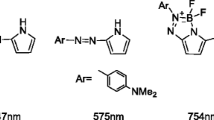Abstract
Taking the 4,5-diphenyl-substituted 2-dimethylamino-3-azacyclopentadienone (4) as an example its colour has been discussed in relation to different basic chromophores (parent chromophores). The parent chromophore can be defined either as the structure which has nearly the same absorption wavelength as the dye under consideration or as the substructure which is electronically most closely related to the dye. In the case of4 both considerations lead to different results. Based on the correlation diagram between the electronic states involved in the electronic excitation the long-wavelength absorption of4 is better understood in terms of the merocyanine parent chromophore than in terms of a betainic substructure, which should have the same colour as4 and is the parent chromophore according toKlessinger. This conclusion is drawn fromPPP configuration analysis of the wavefunctions of4 relative to different molecular substructures. The molecular geometry predicted by the geometry-optimized MINDO/3 and QCFF/Pi calculations provided additional arguments in favour of the cyclomerocyanine structure of4. In respect to the colour4 belongs to a new series of cyclic-conjugated chromophoric systems.
Zusammenfassung
Die Farbe des 4,5-diphenyl-substituierten 2-Dimethylamino-3-azacyclopentadienons (4) wird im Hinblick auf verschiedene Grundchromophore diskutiert. Der Grundchromophor kann entweder mit der Struktur identifiziert werden, welche die gleiche Absorptionswellenlänge wie die betrachtete Verbindung aufweist, oder mit der Struktur, welche elektronisch am stärksten mit dem Farbstoff verwandt ist. Im Falle4 führen beide Betrachtungen zu verschiedenen Ergebnissen. Auf Grund des Korrelationsdiagramms der Elektroenzustände, die in die Anregung eingeschlossen sind, wird die langwellige Absorption von4 besser verstanden als Merocyaningrundchromophor, als durch eine betainische Teilstruktur, welche die gleiche Farbe wie4 aufweisen sollte und nachKlessinger der Grundchromophor ist. Diese Schlußfolgerung wird aus derPPP-Konfigurationsanalyse der Wellenfunktion von4 in bezug auf verschiedene molekulare Teilstrukturen gezogen. Die durch Geometrieoptimierung in MINDO/3 und QCFF/Pi-Näherung berechnete Molekülgeometrie lieferte zusätzlich Argumente zugunsten der Cyclomerocyaninstruktur von4. Bezüglich der Farbe kann4 zu einer neuen Serie cyclisch-konjugierter Chromophore gerechnet werden.
Similar content being viewed by others
References
Griffiths J., Colour and Constitution of Organic Molecules. London: Academic Press. 1976.
Klessinger M., Lüttke W., Tetrahedron19, Suppl. 2, 315 (1963).
Klessinger M., Tetrahedron22, 3355 (1966).
Wille E., Lüttke W., Angew. Chem.83, 853 (1971);Wille E., Lüttke W., Liebigs Ann. Chem.1980, 2039.
Pfeiffer G.,Bauer H., Liebigs Ann. Chem.1980, 564.
Fabian J., Hartmann H., Light Absorption of Organic Colorants. Berlin-Heidelberg-New York: Springer. 1980.
Eicher Th.,Abdesaken F.,Franke G.,Weber J. L., Tetrahedron Letters1975, 3915.
Klessinger M., Chem. uns. Zeit.12, 1 (1978).
Coan St. B., Trucker D. E., Becker E. I., J. Amer. Chem. Soc.75, 900 (1953).
Parr R. G., Quantum Theory of Molecular Structure. New York: W. A. Benjamin. 1964.
Griffiths J., Dyes and Pigments3, 211 (1982).
Mataga N., Nishimoto K., Z. phys. Chem. [Frankfurt am Main]13, 140 (1957).
Tavan P., Schulten K., J. Chem. Phys.70, 5407 (1979).
Polansky O. E., Derflinger G., Int. J. Quantum Chemistry1, 379 (1967);Fujii, Suzuki S., Bull. Chem. Soc. Japan50, 3111 (1977).
Baba H., Suzuki S., Takemura T., J. Chem. Phys.50, 2078 (1969).
Fabian J., Z. Chem.20, 197 (1980).
Fabian J., J. Signalaufzeichnungsmaterialien6, 307 (1978);7, 67 (1979).
Bingham R. C., Dewar M. J. S., Lo D. H., J. Amer. Chem. Soc.97, 1294, 1302 (1975).
Warshel A., Karplus M., J. Amer. Chem. Soc.94, 5612 (1972);Warshel A., in: Modern Theoretical Chemistry (Segal G., ed.), Vol. 7, Chapt. 5. New York: Plenum Press. 1977.
Dewar M. J. S.,Metin M.,Student P. J.,Brown A.,Bingham R. C.,Lo D. M.,Ramsden C. A.,Kollmar M.,Weimar P.,Bischof P. K., QCPE 279, Indiana University, Bloomington.
Warshel A.,Levitt M., QCPE 247, Indiana University, Bloomington.
Heilbronner E., Bock H., The HMO-Model and its Application. New York: John Wiley/Weinheim: Verlag Chemie. 1976.
Fabian J.,Mehlhorn A., unpublished results, 1981.
Hartmann H., Scheithauer St., J. Prakt. Chem.311, 827 (1969).
Fabian J., J. Prakt. Chem.323, 551 (1981).
Fabian J., Tröger G., Teor. Eksp. Khim.7, 170 (1971).
Author information
Authors and Affiliations
Rights and permissions
About this article
Cite this article
Fabian, J., Mehlhorn, A., Dietz, F. et al. What is the basic chromophore of a dye?. Monatsh Chem 115, 21–34 (1984). https://doi.org/10.1007/BF00798418
Received:
Accepted:
Issue Date:
DOI: https://doi.org/10.1007/BF00798418




